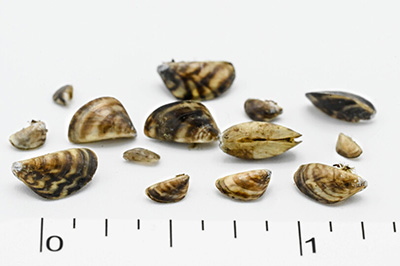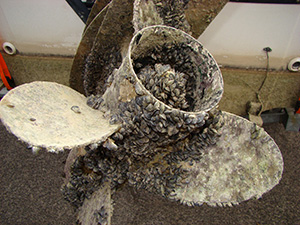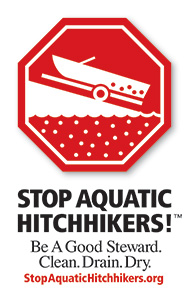Home → Fish & Wildlife → Fisheries → Aquatic Invasive Species → Zebra Mussels
Zebra Mussels
Keep Invasive Zebra Mussels from spreading

Adult zebra mussels are ¾-1 ½ inches in length. At the larval stage
(which is most likely to be transported), zebra mussels are microscopic.

Zebra Mussel Infestations in the Saint John River pose a threat to other Maine waters
Invasive zebra mussels have been found within the Saint John River, with visual confirmations of adult zebra mussels downstream from the hydroelectric dam in Edmundston, New Brunswick. Additional confirmations through the use of environmental DNA and sampling that confirms the presence of larval zebra mussels have shown the presence of zebra mussels through the Saint John River downstream from Madwaska.
This places the entire Saint John River drainage at high risk for further infestation spread and as a potential source for transport on watercraft of zebra mussels into other Maine water bodies. Zebra mussels have not yet been confirmed in any water of the state of Maine outside of the Saint John River but represent a high threat level to the health of our waters, fish, and wildlife. Zebra mussel infestations result in irreversible negative impacts on native species and water body systems and are nearly impossible to eradicate once introduced.
Zebra mussels filter and hold a substantial amount of important food and nutrients that native organisms require, negatively impacting all native fish and wildlife in the water body. In addition to significantly impacting our wildlife, and unlike our native mussels, zebra mussels attach to hard surfaces in the water, including watercraft, pipes (which can clog intake/outflow), rocks, docks, and even native mussels. Zebra mussel larvae are microscopic, making it imperative all outdoor enthusiasts use extreme caution to limit the spread even when they can't see the mussels.
Help limit the spread of zebra mussels

Always practice standard clean, drain, dry recommendations and laws for watercraft.
CLEAN off visible aquatic plants, animals, and mud from watercraft, motor, trailer, and equipment before leaving water access.
DRAIN all water from watercraft. Maine law requires that prior to entering a waterbody and when preparing to leave launch facilities, boaters must remove or open any devices designed for routine removal/opening (for example, hull drain plugs, bailers, live wells, ballast tanks) to encourage draining of areas containing water (excluding live bait containers). This must be done in a way that does not allow drained water to enter any inland water of the state.
DRY all equipment and watercraft completely before reuse. While they can be removed, washed off, and drained out with best cleaning and draining practices,allowing watercraft and all gear to dry thoroughly between water bodies is one of the most effective ways to prevent the spread of these microscopic zebra mussel larvae. This drying should occur for multiple days (2-5 days) when possible.
VOLUNTEER TO HELP MONITOR THE POTENTIAL SPREAD
Zebra mussel infestations can be easily monitored for with a tool called settling plates. If you live on or commonly recreate on lakes in the state, you may be able to help!
Frequently Asked Questions
What is MDIFW doing about the zebra mussel threat?
As part of an initial response plan developed in 2023, the Department is undertaking multiple efforts to proactively address the invasive zebra mussel risk. This includes taking water samples from waterbodies potentially more vulnerable to zebra mussels and testing them for environmental DNA (eDNA) that would indicate zebra mussel presence much earlier than they could be physically detected. Learn more about the use of eDNA for early detection in our blog.
The Department is also continuing the community science program which relies on community members who are regularly visiting a waterbody to use a tool called settling plates to help to detect any potential zebra mussels in waters at risk, click here to learn how you can help out with this community science project. These active monitoring approaches are just one portion of our broader efforts to educate on the threats that all aquatic invasive species pose, emphasizing the need to practice proper clean, drain, dry guidelines. Prevention is the most effective way to limit the spread of invasive species and protect Maine's many water resources.
What are invasive zebra mussels?
Zebra mussels are a freshwater invasive mussel originally from Europe and Russia. Unlike plants or other large aquatic invasive species that are easy to spot by eye, zebra mussels are difficult to detect during watercraft inspections because they are microscopic at the larval stage (which is most likely to be transported) and even in the adult stage only reach ¾-1 ½ inches in length. Their shells are yellow and brown with zig zag stripes; however, the pattern can vary quite a bit.
Do we have zebra mussels in Maine?
Zebra mussels are currently only found in the Saint John River mainstem from Madawaska downstream. This is the first known occurrence of zebra mussels in Maine, however zebra mussels have been spreading in the United States through the Great Lakes region after transport in ballast waters on large cargo ships from Europe and eventual spread through connected riverine systems for decades. This has led to continual spread through additional overland transport on watercraft into inland waters and western portions of the United States that has not yet reached the northeast to the same degree.
Will zebra mussels eventually establish populations in all Maine waters?
Zebra mussels require certain water chemistry attributes, like high calcium levels, to establish and thrive in a water body. The Department of Environmental Protection conducted a study on many of Maine's lakes and found that over 90% of lakes they examined had a very low suitability level for zebra mussels based on water chemistry. In riverine systems, flow rates must be slow enough to allow zebra mussel larvae to eventually attach to hard surfaces, and as a result their spread or densities may be naturally limited in certain extents of our rivers & brooks.
Why are zebra mussels so problematic?
Like our native mussels, they are filter feeders, which means that they feed by drawing in water and consuming primarily algae. However, zebra mussels are far more effective at filtering than our native mussels and take in and hold a substantial amount of important food & nutrients that native organisms require. Native zooplankton and small fish that depend on that food and nutrient supply decrease in abundance as a result, and in turn there is a cascading negative effect on all native fish and wildlife within the system due to the decreased availability of prey at each level of the food web. Unlike our native mussels, zebra mussels attach to hard surfaces in the water, including watercraft, pipes (which can clog intake/outflow), rocks, docks, and even native mussels.